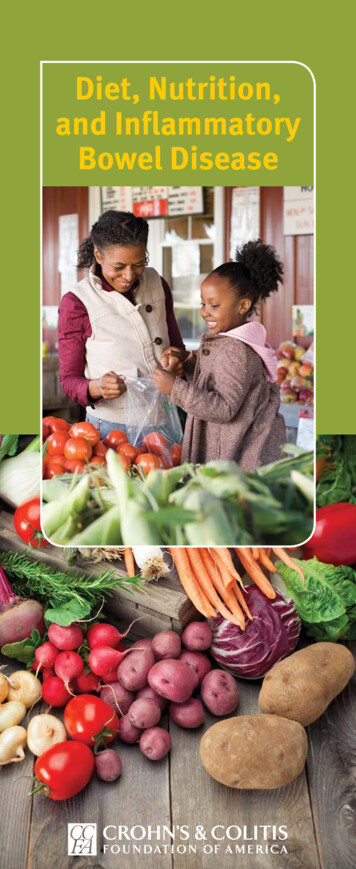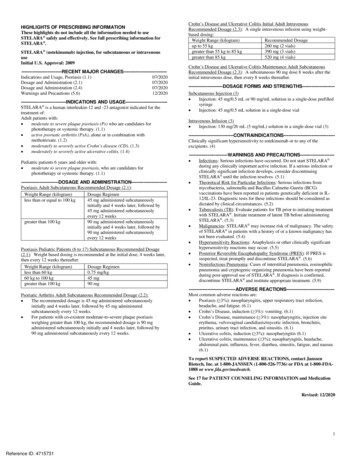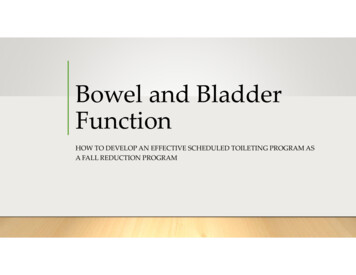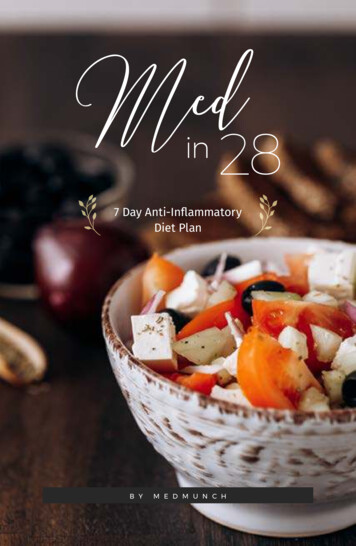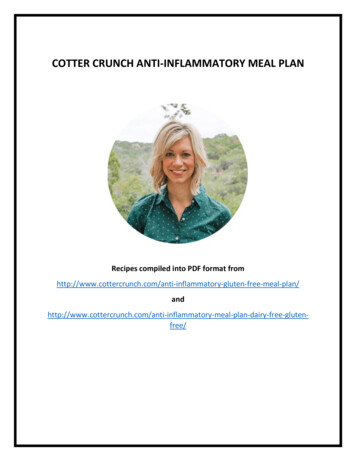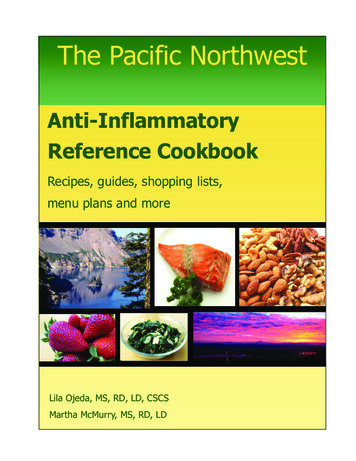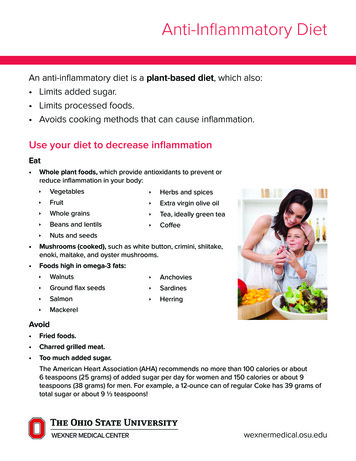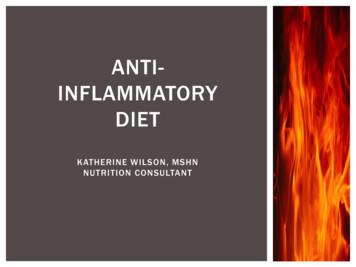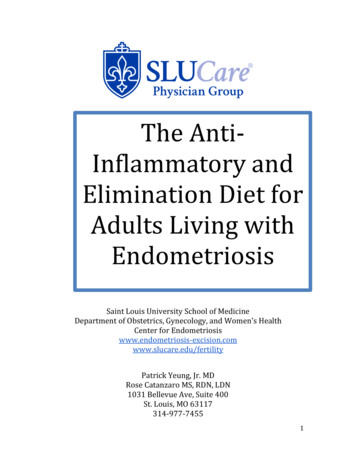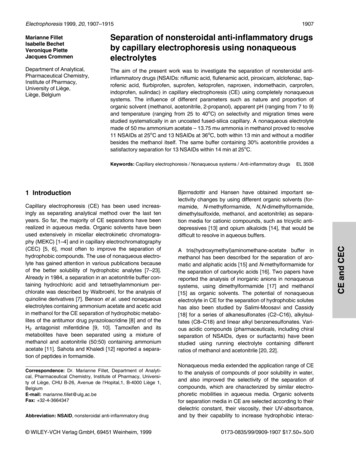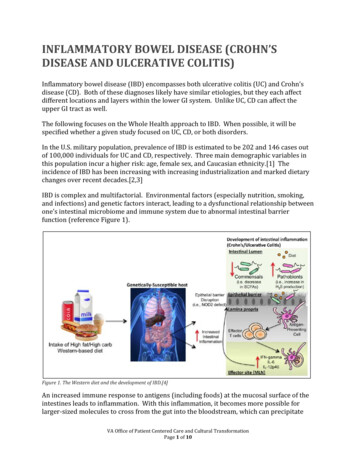
Transcription
INFLAMMATORY BOWEL DISEASE (CROHN’SDISEASE AND ULCERATIVE COLITIS)Inflammatory bowel disease (IBD) encompasses both ulcerative colitis (UC) and Crohn’sdisease (CD). Both of these diagnoses likely have similar etiologies, but they each affectdifferent locations and layers within the lower GI system. Unlike UC, CD can affect theupper GI tract as well.The following focuses on the Whole Health approach to IBD. When possible, it will bespecified whether a given study focused on UC, CD, or both disorders.In the U.S. military population, prevalence of IBD is estimated to be 202 and 146 cases outof 100,000 individuals for UC and CD, respectively. Three main demographic variables inthis population incur a higher risk: age, female sex, and Caucasian ethnicity.[1] Theincidence of IBD has been increasing with increasing industrialization and marked dietarychanges over recent decades.[2,3]IBD is complex and multifactorial. Environmental factors (especially nutrition, smoking,and infections) and genetic factors interact, leading to a dysfunctional relationship betweenone’s intestinal microbiome and immune system due to abnormal intestinal barrierfunction (reference Figure 1).Figure 1. The Western diet and the development of IBD.[4]An increased immune response to antigens (including foods) at the mucosal surface of theintestines leads to inflammation. With this inflammation, it becomes more possible forlarger-sized molecules to cross from the gut into the bloodstream, which can precipitateVA Office of Patient Centered Care and Cultural TransformationPage 1 of 10
Inflammatory Bowel Diseaseeven more of an immune response and inflammation. Interrupting this process shouldform the basis for a Personal Health Plan (PHP) that specifically focuses on regulating theimmune system by decreasing inflammation and by rebalancing and healing the gutmicrobiome. Every individual and his or her disease is unique; thus, a personalized, ratherthan a one-size-fits-all, approach may be most effective.The following recommendations focus on the best available evidence. Although generalhealthy living recommendations are not included, it should be assumed that healthpromoting behaviors are the default for any PHP.MOVING THE BODYIncreasing physical activity leads to improved quality of life, increased muscle mass, anddecreased rates of osteoporosis in those with IBD.[5] This is important, given that thosewith IBD have a 40%-60% increased rate of osteoporotic fractures. This may be due to acombination of increased inflammation, steroid treatment, and micronutrientdeficiencies.[6]SURROUNDINGSHow important are our genes relative to our surroundings in determining our “geneticsusceptibility” to IBD? There is a low concordance rate in identical twins for both CD(about 50%) and UC (about 10%), confirming that the environment is an importantvariable.[3]Given that IBD is unevenly distributed around the world and in different socioeconomicstrata in the United States, some hypothesize that the “hygiene hypothesis” may have anexplanatory role. Humans living in industrialized countries of higher socioeconomic statusare exposed to fewer microbes at an early age. This may cause them to have an immunesystem that is less able to tolerate microbial exposures later in life and whichinappropriately activates, causing inflammation and possibly IBD.[2]FOOD AND DRINKGiven that shifts toward more “Western” diets are likely the most significant variableincreasing IBD rates worldwide, what one eats likely plays a major role in both developingand controlling IBD.Our diets are directly associated with the characteristics of our intestinal bacterialcommunity (our microbiome), which likely play a role in the development of IBD as well.The microbiome stays relatively stable throughout life, starting at the ages of 2 or 3, but itcan be modified through significant dietary changes.[2] For more information, refer toPromoting a Healthy Microbiome with Food and Probiotics.VA Office of Patient Centered Care and Cultural TransformationPage 2 of 10
Inflammatory Bowel DiseaseAlthough research supports a higher rate of food allergies and sensitivities in those with CD(approximately 61%), no recommended diet exists save eating liquid diets during diseaseflares.[7] Some studies support use of specific diets, such as the Specific Carbohydrate Dietor a Low Sulfur Diet, but control groups often were eating a more Westernized diet. It maybe that these IBD diets are actually just “less Western” and therefore all have similareffects.However, most with IBD change their diets after diagnosis. Several small studies haveshown that personalized elimination diets can be helpful, and this dietary approach has thebest clinical evidence for both symptom and histological improvements for CD.[2] Forguidance, refer to “The Elimination Diet”. Given that micronutrient deficiencies arecommon in those with IBD, one must ensure that elimination diets do not become overlyrestrictive.The most common foods that seem to provoke symptoms include dairy (casein, lactose),gluten, wheat, yeast, corn, and certain fruits (citrus, grapes, melon) and vegetables.Given the risk of nutritional deficiencies due to poor absorption or restrictive diets,consider ordering labs focused on determining one’s nutritional health: red blood cell(RBC) magnesium, RBC zinc, serum albumin (or pre-albumin depending on context), serumiron, ferritin, transferrin, folate, B12, and 25-OH vitamin D. The most common deficienciesare folate, B12, and iron.[8]Antioxidants have the ability to bind free radicals, which are often generated frominflammation in IBD. In-vitro evidence supports:[9] Vitamin E (and possibly A and C; all antioxidants)Selenium (anti-inflammatory)Iron (may need to be given IV given difficulties with absorption)Zinc (vital for GI healing)Calcium and vitamin D (bone strength)Folate and B12 (latter may need to be parenteral if the terminal ileum is involved)With the advent of newer biologic medications, specific diet formulas have become lessfrequently used for those with active CD. Such diets have traditionally been used inpediatric populations for whom chronic steroid therapy is undesirable.[10] Enteralnutrition with elemental, semi-elemental, and defined formula diets are nearly as effectivein inducing remission as corticosteroids, and they are much better than placebo with anearly 60% response rate.[11]The type of formula does not seem to matter because it is not the protein or nitrogensource but likely the fat content that leads to benefit. It is believed to work through both ananti-inflammatory interaction of lipids with the intestinal mucosa as well as by changingthe colonic microflora.[12] In UC, this approach does not seem to be effective.[2] However,relapses after discontinuing these diets are common, and the diets are often unpalatable.Although few supporting data exist, it seems reasonable to suggest an anti-inflammatoryVA Office of Patient Centered Care and Cultural TransformationPage 3 of 10
Inflammatory Bowel Disease(or Mediterranean) diet given its better palatability and known positive effects on otheraspects of health.Finally, there are several plant-based compounds that have shown great promise as antiinflammatory and antioxidants in basic science and animal studies. Clinical studies in thosewith IBD are lacking, and these should be highlighted in one’s diet until more is known:[9] RESTResveratrol. This is naturally found in grapes, peanuts, and red wine.Bromelain. This is a mixture of enzymes derived from pineapples.Pomegranate. Likely quite safe, given it is a popular food.Rutin. This is a polyphenolic flavonoid found in citrus fruits, tea, and buckwheatseeds.Sleep modulates the immune response and therefore may affect the course of inflammatorydiseases. Those with IBD often have disordered sleep, as exhibited by prolonged sleeplatency, sleep fragmentation, higher sleep medication use, decreased daytime energy, andpoor overall sleep quality. These observations are true even when IBD is not active.[13]Although there is likely a circular interplay between sleep dysfunction and inflammation,helping to restore healthy sleep patterns may improve quality of life and possibly diseaseseverity.POWER OF THE MINDThe gut is the body’s emotional spinal cord.[14]People with IBD are at a greater risk of anxiety, depression, and impaired quality of life.They also have altered sensory perceptions, as suggested by increased sensitivity to hotand cold.[13] A review of mind-body approaches concluded the following: Stress management techniques can have a modest benefit on disease severity andquality of life.Cognitive behavioral therapy (CBT) improves mood but not IBD severity.Hypnosis has a positive impact on disease severity as well as mental healthsymptoms.[15]These may be best utilized with people who have concomitant mental health disorders.ROLE OF PREVENTION AND SCREENINGDiet. Western diets are high in total fat, animal fats, and omega-6 polyunsaturated fats aswell as low in fiber and high in refined carbohydrates. High fiber and fruit intakes areVA Office of Patient Centered Care and Cultural TransformationPage 4 of 10
Inflammatory Bowel Diseaseassociated with a decreased UC risk.[2] Retrospective data suggest that a high intake offiber and fruit (but not vegetables) is associated with a reduced risk of CD.[3] Conversely, ahigh intake of vegetables (but not fruit) is associated with a reduced risk of UC.[3]Tobacco use. Smoking increases the incidence of CD and worsens its course. However,smoking is protective against UC, and patients with UC who smoke should not necessarilybe encouraged to stop depending on an overall assessment of the risks and benefits.[5]Breastfeeding. This protects against IBD, especially if continued for 6 months afterbirth.[11]Avoiding antibiotics. There is a possible association between long-term antibiotic use(especially doxycycline) for acne and CD. This suggests that long-term and repeatedexposure to antibiotics should be avoided unless absolutely indicated.[16]Other risk factors for IBD include family history, age 15-35 and 55-65, female sex, urbandweller, high stress, Jewish ancestry, high socioeconomic status. Possible risks includeNSAIDs, oral contraceptives, antibiotics, and bacterial intestinal infections.[7]Screening for colon cancer. UC is associated with an increased risk of colon cancer,though this risk varies based on the site(s) of disease and duration of symptoms (and notits activity). Epidemiologic data has shown that proctitis alone confers no additional risk,but pancolitis that began in childhood confers a 162 times higher colon cancer riskcompared to those who do not have UC.[17] It is best to be screened when the disease is inremission. The frequency of screening has not been rigorously studied and should beindividualized. Many guidelines recommend screening initiation 10 years after diagnosiswith follow up every 1 to 5 years. Patients with CD do not appear to have an increased riskof colon cancer, though this is still being investigated; however, they may have an increasedrisk of small bowel cancer, though no reliable screening methods exist for this. Also,women taking immunosuppressive therapy may be at higher risk of cervical cancer, soclose adherence to current screening guidelines is recommended.Note: Please refer to the Passport to Whole Health, Chapter 15 on Dietary Supplements formore information about how to determine whether or not a specific supplement isappropriate for a given individual. Supplements are not regulated with the same degree ofoversight as medications, and it is important that clinicians keep this in mind. Productsvary greatly in terms of accuracy of labeling, presence of adulterants, and the legitimacy ofclaims made by the manufacturer.DIETARY SUPPLEMENTS AND BOTANICALSOmega-3 fatty acids have not been shown to work in most studies and have had marginalbenefit in others. While they have known anti-inflammatory properties in vitro and in vivo,they have not shown a clinical benefit in IBD. That said, they are often one of the mostcommon supplements taken by those with IBD.[18-23]VA Office of Patient Centered Care and Cultural TransformationPage 5 of 10
Inflammatory Bowel DiseaseCurcumin, a component of turmeric, showed promise in a few small studies for both CDand UC.[19] It has well-characterized anti-inflammatory and antioxidant effects. It is aCOX-2 and lipoxygenase inhibitor. The dose is 1,000 mg twice per day with meals.[24]Curcumin has been used in trials along with pharmaceuticals, so the current best evidencesupports using it as an adjuvant therapy.[25]Aloe vera gel is the mucilaginous aqueous extract of the aloe leaf. It has been shown to bebetter than placebo in moderately active UC in a study of 30 patients over 4 weeks. It is themost popular botanical used by those with IBD. For UC, use 100 mL of a 50% solutiontwice daily. Be careful not to recommend aloe latex, as this acts as a laxative and canworsen diarrhea.[19]Wheatgrass juice (Triticum aestivum) is better than placebo in inducing a clinicalresponse for active distal UC in 23 patients over 4 weeks.[19] The amount used is 20 mLorally per day initially. This is increased by 20 mL per day to 100 mL total.Boswellia serrata is a traditional Ayurvedic remedy and a component of incense. It is alsoknown as Indian frankincense. It has been shown to be equal to sulfasalazine formoderately active UC and equal to mesalamine for CD in inducing a clinical responseand/or remission. The dose used in the research was 300 mg three times daily for 6weeks.[19]Psyllium reduced symptoms and increased remission times in those with UC who took 20grams with their mesalamine versus using mesalamine alone. Use caution, as taking thisduring flares can make symptoms worse.[26]Probiotics—Given that specific bacterial species exhibit anti-inflammatory effects and canpositively alter the intestinal ecosystem, studying the effects of probiotics on IBD makeslogical sense. Although significant research is being done, each individual likely has auniquely dysfunctional gut microbiome, so individualized therapies will likely prove themost useful.[27,28] Novel, culture-independent DNA sequencing is revolutionizing ourability to understand this, and the research is becoming more positive over time. Severalprobiotic species alone or in combination have been studied and show the most promise inrelapse prevention and remission induction in mild to moderate UC.[6,29] A meta-analysisexamining probiotics’ effectiveness in CD revealed no overall benefit, but there is somesuggestion that Lactobacillus rhamnosus GG or Saccharomyces boulardii may bebeneficial.[30-32] The following can be considered: VSL#3 (active UC, inactive pouchitis).[33,34] One sachet twice per day. Thiscontains eight strains of Bifidobacterium, Lactobacillus, and Streptococcus species.This product contains corn.Lactobacillus rhamnosus strain GG 10 to 20 billion colony-forming units (CFUs) perday.Saccharomyces boulardii 250 mg three times per day or 500 mg twice daily.For more information, refer to “Promoting a Healthy Microbiome with Food andProbiotics.”VA Office of Patient Centered Care and Cultural TransformationPage 6 of 10
Inflammatory Bowel DiseasePrebiotics. These are nonabsorbable carbohydrates that enhance the growth of beneficialintestinal bacteria (e.g., Lactobacillus). They provide a substrate for the generation ofshort-chain fatty acids (SCFAs), which possess anti-inflammatory properties; the mostrepresentative of these is butyrate.[4] Enteric-coated butyrate capsules (4 grams daily) incombination with mesalamine versus mesalamine alone improved symptoms in patientswith mild to moderate UC.[26]TABLE 1. FOOD SOURCES OF PREBIOTICS [35]FoodRaw Chicory RootRaw Jerusalem ArtichokeRaw Dandelion GreensRaw GarlicRaw OnionCooked OnionRaw AsparagusCooked Whole Wheat FlourRaw BananaOTHER SYSTEMSAmount to Eat to Get 10 Grams (g) ofPrebiotics15.5 g (0.6 oz)31.7 g (1.1 oz)40 g (1.4 oz)57.2 g (2 oz)116.3 g (4.1 oz)200 g (7.1 oz)200 g (7.1 oz)208.3 g (7.3 oz)1000 g (2.2 lbs.)In two meta-analyses including 48 randomized controlled trials, acupuncture withmoxibustion and moxibustion alone demonstrated better efficacy than oral sulfasalazine intreating IBD. However, results were quite variable, and the studies were of lowmethodological quality. These therapies show promise, but research is insufficient tosupport making a strong recommendation.[36,37]Non-pharmaceutical treatment recommendations for CD versus UC are summarized inTable 2.TABLE 2. SUMMARY OF NON-PHARMACEUTICAL TREATMENTSTreatmentCrohn’s diseaseUlcerative colitisDefined formula dietsEffective but may beunnecessary; considerelimination dietNot effectiveLactobacillus rhamnosus GGSaccharomyces boulardiiVSL#3Colon cancer screening Unknown intervalProbiotics10 years after diagnosis,then every 1-5 yearsVA Office of Patient Centered Care and Cultural TransformationPage 7 of 10
Inflammatory Bowel DiseaseTreatmentCrohn’s diseaseUlcerative colitisPrebioticsNot applicableVia food; consider butyratecapsules or enemasAloe vera gel—100 mL twice dailyCurcuminBoswellia serrataPsyllium huskWheatgrass juice1 gram twice daily withmeals300 mg three times daily20 grams daily—1 gram twice daily withmeals300 mg three times daily—20-100 mL orally/dayFor everyone with IBD, the following should be strongly considered: Cease use of tobacco productsIncrease physical activity, especially weight-bearing activities.Start an individualized elimination diet. Refer to the “Elimination Diet” tool.Promote colorful anti-inflammatory foods.Consider a multivitamin to reduce pro-oxidant load.Address stress management by one or more therapies including hypnosis, CBT, orother mindfulness-based techniques.Address suboptimal sleep.Test for possible nutritional deficiencies: RBC magnesium, RBC zinc, serum albumin(or pre-albumin depending on context), serum iron, ferritin, transferrin, folate, B12,and 25-OH vitamin D.Caution in using NSAIDs and oral contraceptives (the latter are a risk factor for CDand may not be as effective in those with IBD).Consider acupuncture and/or moxibustion.AUTHOR(S)“Inflammatory Bowel Disease” was written by David Lessens, MD, MPH (2014). Sections ofthis Whole Health tool were adapted from “An Integrative Approach to InflammatoryBowel Disease (IBD)” by Srivani Sridhar, MD.This Whole Health tool (or overview) was made possible through a collaborative effortbetween the University of Wisconsin Integrative Health Program, VA Office of PatientCentered Care and Cultural Transformation, and Pacific Institute for Research andEvaluation.VA Office of Patient Centered Care and Cultural TransformationPage 8 of 10
Inflammatory Bowel 15.16.17.18.19.Betteridge JD, Armbruster SP, Maydonovitch C, Veerappan GR. Inflammatory boweldisease prevalence by age, gender, race, and geographic location in the U.S. militaryhealth care population. Inflamm Bowel Dis. 2013;19(7):1421-1427.Albenberg LG, Lewis JD, Wu GD. Food and the gut microbiota in inflammatory boweldiseases: a critical connection. Curr Opin Gastroenterol. 2012;28(4):314-320.Boeing H, Bechthold A, Bub A, et al. Critical review: vegetables and fruit in theprevention of chronic diseases. Eur J Nutr. 2012;51(6):637-663.Leone V, Chang EB, Devkota S. Diet, microbes, and host genetics: the perfect storm ininflammatory bowel diseases. J Gastroenterol. 2013;48(3):315-321.Cosnes J. Smoking, physical activity, nutrition and lifestyle: environmental factorsand their impact on IBD. Dig Dis. 2010;28(3):411-417.Lucendo AJ, De Rezende LC. Importance of nutrition in inflammatory bowel disease.World J Gastroenterol. 2009;15(17):2081-2088.Brown AC, Roy M. Does evidence exist to include dietary therapy in the treatment ofCrohn's disease? Expert Rev Gastroenterol Hepatol. 2010;4(2):191-215.Gassull MA. Review article: the role of nutrition in the treatment of inflammatorybowel disease. Aliment Pharmacol Ther. 2004;20 Suppl 4:79-83.Singh UP, Singh NP, Busbee B, et al. Alternative medicines as emerging therapies forinflammatory bowel diseases. Int Rev Immunol. 2012;31(1):66-84.Griffiths AM. Enteral nutrition in the management of Crohn's disease. JPEN Journal ofparenteral and enteral nutrition. 2005;29(4 Suppl):S108-112; discussion S112-107,S184-108.Cabre E, Domenech E. Impact of environmental and dietary factors on the course ofinflammatory bowel disease. World J Gastroenterol. 2012;18(29):3814-3822.Griffiths AM. Enteral feeding in inflammatory bowel disease. Curr Opin Clin NutrMetab Care. 2006;9(3):314-318.Ranjbaran Z, Keefer L, Farhadi A, Stepanski E, Sedghi S, Keshavarzian A. Impact ofsleep disturbances in inflammatory bowel disease. J Gastroenterol Hepatol.2007;22(11):1748-1753.Skrautvol K, Naden D. Nutritional care in inflammatory bowel disease--a literaturereview. Scand J Caring Sci. 2011;25(4):818-827.Knowles SR, Monshat K, Castle DJ. The efficacy and methodological challenges ofpsychotherapy for adults with inflammatory bowel disease: a review. Inflamm BowelDis. 2013;19(12):2704-2715.Margolis DJ, Fanelli M, Hoffstad O, Lewis JD. Potential association between the oraltetracycline class of antimicrobials used to treat acne and inflammatory boweldisease. Am J Gastroenterol. 2010;105(12):2610-2616.Botoman VA, Bonner GF, Botoman DA. Management of inflammatory bowel disease.Am Fam Physician. 1998;57(1):57-68, 71-52.Cabre E, Manosa M, Gassull MA. Omega-3 fatty acids and inflammatory boweldiseases - a systematic review. Br J Nutr. 2012;107 Suppl 2:S240-252.Langmead L, Rampton DS. Review article: complementary and alternative therapiesfor inflammatory bowel disease. Aliment Pharmacol Ther. 2006;23(3):341-349.VA Office of Patient Centered Care and Cultural TransformationPage 9 of 10
Inflammatory Bowel 4.35.36.37.Meister D, Ghosh S. Effect of fish oil enriched enteral diet on inflammatory boweldisease tissues in organ culture: differential effects on ulcerative colitis and Crohn'sdisease. World J Gastroenterol. 2005;11(47):7466-7472.Turner D, Shah PS, Steinhart AH, Zlotkin S, Griffiths AM. Maintenance of remission ininflammatory bowel disease using omega-3 fatty acids (fish oil): a systematic reviewand meta-analyses. Inflamm Bowel Dis. 2011;17(1):336-345.Turner D, Steinhart AH, Griffiths AM. Omega 3 fatty acids (fish oil) for maintenanceof remission in ulcerative colitis. Cochrane Database Syst Rev. 2007(3):Cd006443.Turner D, Zlotkin SH, Shah PS, Griffiths AM. Omega 3 fatty acids (fish oil) formaintenance of remission in Crohn's disease. Cochrane Database Syst Rev.2009(1):Cd006320.Ali T, Shakir F, Morton J. Curcumin and inflammatory bowel disease: biologicalmechanisms and clinical implication. Digestion. 2012;85(4):249-255.Kumar S, Ahuja V, Sankar MJ, Kumar A, Moss AC. Curcumin for maintenance ofremission in ulcerative colitis. Cochrane Database Syst Rev. 2012;10:Cd008424.Ke F, Yadav PK, Ju LZ. Herbal medicine in the treatment of ulcerative colitis. Saudi JGastroenterol. 2012;18(1):3-10.Do VT, Baird BG, Kockler DR. Probiotics for maintaining remission of ulcerativecolitis in adults. Ann Pharmacother. 2010;44(3):565-571.Mack DR. Probiotics in inflammatory bowel diseases and associated conditions.Nutrients. 2011;3(2):245-264.Sang LX, Chang B, Zhang WL, Wu XM, Li XH, Jiang M. Remission induction andmaintenance effect of probiotics on ulcerative colitis: a meta-analysis. World JGastroenterol. 2010;16(15):1908-1915.Rahimi R, Nikfar S, Rahimi F, et al. A meta-analysis on the efficacy of probiotics formaintenance of remission and prevention of clinical and endoscopic relapse inCrohn's disease. Dig Dis Sci. 2008;53(9):2524-2531.Shen J, Ran HZ, Yin MH, Zhou TX, Xiao DS. Meta-analysis: the effect and adverseevents of Lactobacilli versus placebo in maintenance therapy for Crohn disease.Intern Med J. 2009;39(2):103-109.Schultz M, Timmer A, Herfarth HH, Sartor RB, Vanderhoof JA, Rath HC. LactobacillusGG in inducing and maintaining remission of Crohn's disease. BMC Gastroenterol.2004;4:5.Jonkers D, Penders J, Masclee A, Pierik M. Probiotics in the management ofinflammatory bowel disease: a systematic review of intervention studies in adultpatients. Drugs. 2012;72(6):803-823.Meijer BJ, Dieleman LA. Probiotics in the treatment of human inflammatory boweldiseases: update 2011. J Clin Gastroenterol. 2011;45 Suppl:S139-144.Moshfegh AJ, Friday JE, Goldman JP, Ahuja JK. Presence of inulin and oligofructose inthe diets of Americans. J Nutr. 1999;129(7 Suppl):1407s-1411s.Ji J, Lu Y, Liu H, et al. Acupuncture and moxibustion for inflammatory boweldiseases: a systematic review and meta-analysis of randomized controlled trials.Evid Based Complement Alternat Med. 2013;2013:158352.Lee DH, Kim JI, Lee MS, Choi TY, Choi SM, Ernst E. Moxibustion for ulcerative colitis:a systematic review and meta-analysis. BMC Gastroenterol. 2010;10:36.VA Office of Patient Centered Care and Cultural TransformationPage 10 of 10
Figure 1. The Western diet and the development of IBD.[4] An increased immune response to antigens (including foods) at the mucosal surface of the intestines leads to inflammation. With this inflammation, it becomes more possible for larger-sized molecules to cross
